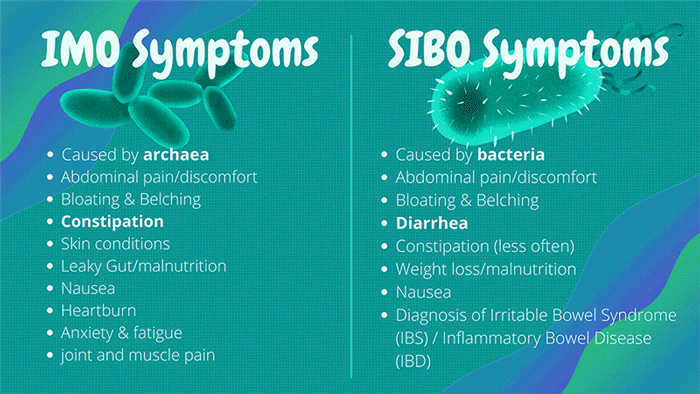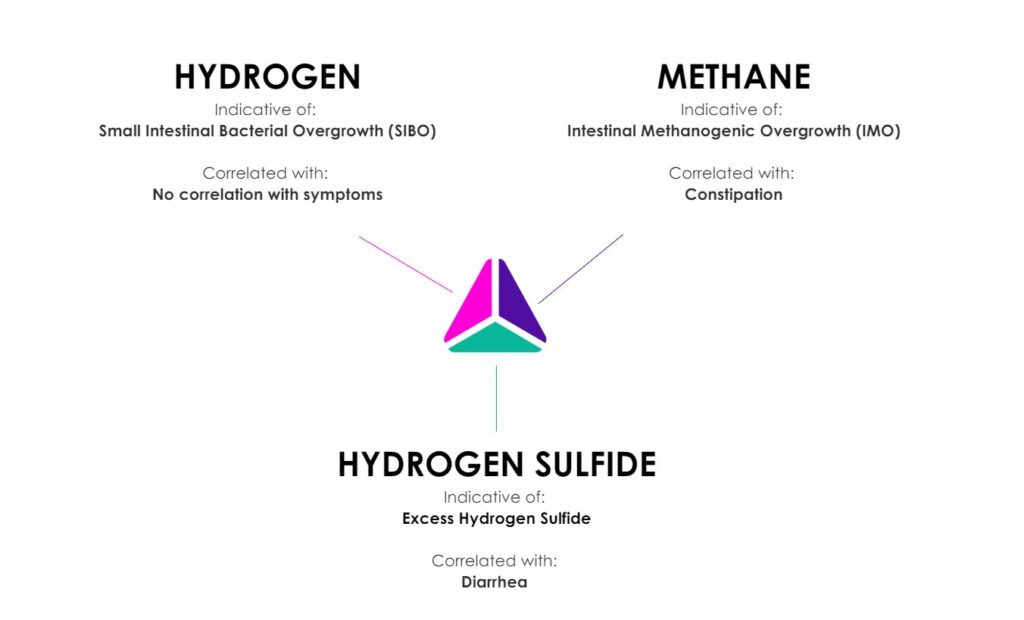
PacificDX is the only lab certified to run trio-Smart, a breath test developed by Gemelli. trio-smart measures the standard H2, CH4, and CO2 and is the only BT that also measures hydrogen sulfide.
You are at a fancy dinner party wearing your favorite dress and after the delicious meal, you are conversing with an old friend whom you have not met since high school. Suddenly, your stomach begins to churn uncomfortably then ache. You have to excuse yourself to rush to the bathroom.
We all at one point suffered uncomfortable bloating and abdominal pain. For some, individuals with irritable bowel syndrome (IBS), these symptoms are chronic. Unfortunately, symptomatic individuals are frequently not diagnosed because they do not seek medical aid. Doctors recommend individuals be tested for IBS if they have recurring abdominal pain for at least 1 day per week in the last 3 months and experience symptoms that include bloating, constipation, diarrhea, incontinence, stress, and/or anxiety.1
What Causes SIBO?
Small intestine bacteria growth is highly prevalent in those who test positive for IBS. SIBO occurs when bacteria that normally occupy the large intestine, overgrow in the small intestine. This occurs because of a variety of factors including physical obstructions, muscle scarring caused by surgeries or Crohn’s disease, medications, antibiotics, and, a diet high in alcohol, sugar, and/or high-carb foods.2 SIBO is divided into different classes.3
- SIBO-D: diarrhea (generally caused by hydrogen-producing bacteria)
- SIBO-C: constipation (excessive methane)
- IBS-M (Mixed) also known as IBS-A (alternating): Alternating constipation and diarrhea.
What Causes IMO?
SIBO was used as a blanket diagnosis for years to diagnose digestive issues but it did not account for organisms in the digestive tract that were not bacteria.4 SIBO-C or methane related SIBO has been reclassified as intestinal methanogenic overgrowth (IMO) because symptoms are caused by high levels of archaea, not bacteria.
The most common species is Methanobrevibacter smithii, which prevents the body from absorbing and utilizing nutrients. Food that would regularly be fully digested, sits in the digestive tract and rots. Archaea digest carbohydrates that are normally absorbed by the body and produce methane in the intestinal tract, causing a “leaky gut” and damage to the enteric nervous system.4

Infographic by Amanda Nguyen
How To Test
There are multiple methods to test for SIBO.
- The current gold standard is the aspiration of small bowel fluid followed by a bacterial count through culture.5 However, this test is intrusive and can be inaccurate. Mid and distal segments are out of reach of normal endoscopes and can yield falsely negative results. Also, contamination of esophageal and oral bacteria can yield falsely positive results.6
- Organix Dysbiosis: tests byproducts of microbial metabolism in the urine.7 However this test cannot identify if a patient has hydrogen dominant or methane dominant SIBO.2
- Trial and error: A doctor listens to a patient’s symptoms, health history, lifestyle factors and prescribes different medications to see which ones alleviate the patient’s symptoms.
- An alternative method of diagnosis for SIBO and IMO is a breath test. (BT)2 BT’s measure hydrogen, methane, and carbon dioxide levels that are diffused in the abdominal venous structures and transported to the lungs.8,10 Companies that conduct BT’s include Quin Tron™, CDI™, Aerodiagnostics™, and Gemelli.
trio-smart®
PacificDX is the only lab certified to run trio-smart, a breath test developed by Gemelli. trio-smart measures the standard H2, CH4, and CO2 and is the only BT that also measures hydrogen sulfide.
H2S linked SIBO is produced by bacteria that utilize H2 to produce H2S.9, Sulfate-reducing bacteria (SRB) produces hydrogen sulfide and competes for nutrients. H2S also interferes with the metabolic processes and damages the intestinal mucosa by disturbing the homeostasis of the gastrointestinal environment. This could cause inflammation leading to bowel disease.9, 10
 Image by trio-smart™
Image by trio-smart™
Trio-smart enables doctors to accurately diagnose patients with hydrogen sulfide related SIBO. Previously, after BT’s returned negative for H2 and CH4, doctors had to assume symptoms were caused by H2S bacteria and prescribed more invasive methods to diagnose or guessed based on patient symptoms. However, Trio-Smart delivers a full diagnostic report of H2, CH4, CO2, and H2S levels in an easy-to-read report.
According to the Division of Gastroenterology, researchers have met a consensus that10:
- An increase of ≥ 20 p.p.m. from the baseline measurement of H2 should be considered positive for SIBO
- A measurement of ≥ 10 p.p.m of CH4 should be considered positive for IMO
- If neither increases, when there are still SIBO/IMO symptoms, H2S producing bacteria should be tested for
- The mean maximum H2S level is higher in patients with diarrhea (5.99±1.96), a common symptom of patients with H2S bacteria
Preparing For The Breath Test
The North American Consensus on Breath Testing (BT) for GI disorders recommends:
The month prior to the BT:
- Antibiotics should be avoided
A week prior to the BT:
- Promotility drugs and laxatives should be stopped if tolerated by the patient
The day before and of the BT:
- 8-12 hour fast period prior to the BT
- Complex carbohydrates (beans, peas, whole grains, nuts, and corn) should be avoided on the day prior to breath testing.
- During this time period, the patient should restrict their diet to meat, tofu, eggs, and white rice; limit seasonings to oil salt, and pepper; and drink only water, coffee, and tea without dairy
- Smoking should be avoided on the day of the BT
- Physical activity should be limited during the BT
For more information on how to order visit the trio-smart website.
Citations
- Takakura, Will, and Mark Pimentel. “Small Intestinal Bacterial Overgrowth and Irritable Bowel Syndrome – An Update.” Frontiers in Psychiatry, Frontiers Media S.A., 10 July 2020, www.ncbi.nlm.nih.gov/pmc/articles/PMC7366247/.
- Myers, Dr. Amy, and Amy Myers. “10 Signs You Have SIBO – Small Intestinal Bacterial Overgrowth.” Amy Myers MD, 23 Dec. 2020, www.amymyersmd.com/article/sibo-small-intestinal-bacterial-overgrowth-symptoms/.
- “What Is IBS With Alternating Constipation and Diarrhea?” WebMD, WebMD, 22 Apr. 2019, www.webmd.com/ibs/what-is-ibs-m.
- Brody, Robert. “Intestinal Methanogen Overgrowth (IMO).” Brodynd.com, brodynd.com/intestinal-methanogen-overgrowth/.
- Simren M, Stotze PO. Use and abuse of hydrogen breath tests. Gut 2006;55:297-303
- Jacobs c, Coss Adame E, Attaluri A et al. Dysmotlilty and proton pump inhibitor uses are independent risk factors for small intestinal bacteria and /or fungal overgrowth Aliment Pharmocaial Ther 2013;37:1103-11
- O’Neal, Stephen. “Organix Dysbiosis Profile by Metametrix.” Integrative Psychiatry, www.integrativepsychiatry.net/shop/metametrix/organix-dysbiosis-profile-metametrix/.
- Levitt MD. Volume and composition of human intestinal gas determined by means of an intestinal washout technic. N Engl J Med 1971; 2841394-8
- Dordević, Dani, et al. “Hydrogen Sulfide Toxicity in the Gut Environment: Meta-Analysis of Sulfate-Reducing and Lactic Acid Bacteria in Inflammatory Processes.” Journal of Advanced Research, Elsevier, 17 Mar. 2020, www.sciencedirect.com/science/article/pii/S2090123220300527.
- Rezaie, Ali, et al. “Hydrogen and Methane-Based Breath Testing in Gastrointestinal Disorders: The North American Consensus.” Hydrogen and Methane-Based Testing in Gastrointestinal Disorders: The North American Consensus, vol. 112, 21 Mar. 2017, pp. 775–785., doi: The American Journal of Gastroenterology.
Photo Credit: Sora Shimazaki from Pexels
